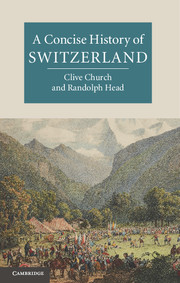Book contents
- Frontmatter
- Contents
- List of Illustrations
- List of Figures
- List of Maps
- Acknowledgements
- List of Abbreviations
- Introduction Making the Swiss
- 1 Before Switzerland
- 2 Creating the Swiss Confederacy, 1386–1520
- 3 A divided Switzerland in Reformation Europe, 1515–1713
- 4 The Ancien Régime, 1713–1798
- 5 Revolution and contention, 1798–1848
- 6 Forging the new nation, 1848–1914
- 7 The shocks of war, 1914–1950
- 8 The Sonderfall years, 1950–1990
- 9 Since 1989
- Chronology
- Glossary
- Further Reading
- Index
Introduction - Making the Swiss
Time, myth and history
Published online by Cambridge University Press: 05 June 2013
- Frontmatter
- Contents
- List of Illustrations
- List of Figures
- List of Maps
- Acknowledgements
- List of Abbreviations
- Introduction Making the Swiss
- 1 Before Switzerland
- 2 Creating the Swiss Confederacy, 1386–1520
- 3 A divided Switzerland in Reformation Europe, 1515–1713
- 4 The Ancien Régime, 1713–1798
- 5 Revolution and contention, 1798–1848
- 6 Forging the new nation, 1848–1914
- 7 The shocks of war, 1914–1950
- 8 The Sonderfall years, 1950–1990
- 9 Since 1989
- Chronology
- Glossary
- Further Reading
- Index
Summary
Modern nations are layered entities embracing geographical regions, their specific political systems, local populations and cultures, and the various communities within and beyond them. When the nation in question, like modern Switzerland, has clearly traceable roots that go back 500 years and more, the layers become complex, woven into a historical fabric that tenaciously influences how both insiders and outsiders view it. Such a fabric is a critical feature of Switzerland’s history. We can say with confidence that people calling themselves ‘Swiss’ have lived north of, and to some extent in and even south of, the central Alps since the late 1400s. They took this name from Schwyz, which was just one of the Orte (places) that made up the Grosser Oberdeutscher Bund Stetten und Lender (Great Upper German League of Cities and Territories) – the political alliance that formed the core of what eventually became modern Switzerland.
This book traces a path that began among this loose network of relatively autonomous communities north of the Alps – among them Schwyz – that began joining into alliances by about 1300. These developed into a ramshackle but surprisingly durable Confederacy by the 1450s, and survived Europe’s tumults to become the multi-lingual and multi-religious federal republic of 2013. Switzerland’s relative political stability since its constitutional foundation in 1848, in a Europe otherwise much troubled by political crisis, led many observers to emphasize the continuity from those earliest associations to the present, and to pay much less attention to the many bitter conflicts that divided the Swiss, and to the ties that linked them to other regions no longer part of Switzerland. Modern historians have recovered the conflict as well as the continuity that characterized this region – not least the four significant internal wars between 1444 and 1715 – leading to a more nuanced picture.
- Type
- Chapter
- Information
- A Concise History of Switzerland , pp. 1 - 10Publisher: Cambridge University PressPrint publication year: 2013

